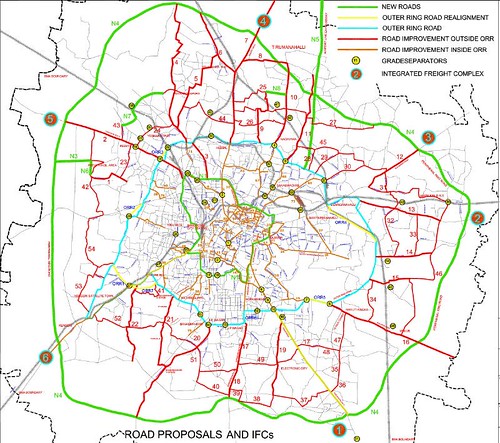7.9 Road Infrastructure
7.9 ROAD INFRASTRUCTURE
The present road network consists of the Ring Roads and major radial corridors. A number of proposals have already been very broadly included in the Master Plan 2015. In addition quite a few proposals are being implemented by Govt. agencies like NHAI, State PWD, BMC, BDA, BMRDA and BMICAPA along with the private sector through PPP model. It is necessary to integrate / superimpose all these proposals in the light of projected travel demand for road traffic and confirm that they are in conformity with each other and there is neither conflict nor duplication. As the radial road corridors are expected to have high traffic volume, these corridors have been proposed to be strengthened instead of isolated improvements. The road improvement proposals include road widening, new roads (bypasses and other roads), ORR realignment, grade separators (road flyovers, ROBs, RUBs), Integrated Freight Complexes etc. These proposals are explained below.
See attachment for the rest of the section. (pdf 107.1kb).
The following the figures in the section:
Figure 7.3 Road Cross Sections - download image here (pdf 203.2 kb)
Figure 7.4 Road Proposals & Integrated Freight Complexes
(click on image for higher resolution)
| Attachment | Size |
|---|---|
| 7_9_Road_Infra.pdf | 107.01 KB |
Parking & traffic congestion

There is an urgent need for a paradigm shift on two counts. Firstly, shift focus from road widening to junction improvement. Secondly, shift focus to create parking infrastructure.
Pravin Sood, additional commissioner of police (traffic & security)
As a child, I read a story about six blind men asked to describe what an elephant looked like by feeling different parts of its body. The first man, who felt the leg, said the elephant was like a pillar; the other, who felt the tail, said it was like a rope; the one who felt the ear said the elephant was like a hand fan and so on. Their descriptions differed because each experienced different parts. There's an analogy between this story and our understanding of the traffic problem.
There is an urgent need for a paradigm shift on two counts. Firstly, shift focus from road widening to junction improvement. Increasing capacity of roads without addressing capacity of junctions negates benefits accruing from the investment. Even after road widening, in the absence of grade separators at junctions, vehicles reach the junctions faster and then wait there for clearance.
Moreover, road widening requires much more effort in terms of land acquisition, cutting of trees, shifting of utilities and confrontation with pressure groups with different mandates. Also, wider roads could become natural parking lots. Not that road widening should not be done. In fact, Bangalore has the distinction of lowest road-to-area ratio in the country. But, Bangalore also has a rare distinction of having more than 40,000 junctions of which 1,000 are on arterial roads; and, of these about 100 signalised junctions across 14 corridors spanning about 59 km carry 50% of the total traffic in a day. The issue is not `road' or `junction' but `road and junction' improvement. Unless junction improvement accompanies corridor improvements, the full benefits of road widening can never be experienced.
Secondly, shift focus to create parking infrastructure. Major roads have been made one-ways while part of these roads is used for parking; 30% of the arterial road space is used as parking lots. Why do we invest in road widening, when they end up as parking lots? Why not invest the same money for parking infrastructure? Removing parking on roads is easier said than done. Considering the flourishing economic activities in parking space (basements) and near absence of parking infrastructure, it's a distant dream. Theoretically, if on-street and footpath parking is totally eliminated, hundreds of schools, commercial establishments and even government offices will have to close down. To expect police to do something like this is denying the existence of malignancy in the system.
Why can't we convert a few one-ways into two-ways? We can, if roads are kept only for moving vehicles, not for parking and certainly not for pedestrians. In our society, most of the economy survives on encroachment of public spaces.
Enforcement without creating alternatives can never be a solution. Of the 35 lakh vehicles on the roads every day, not even 20% are parked throughout the day at earmarked places. Is it possible to tow away 80% of the vehicles? Where is the parking space for all the vehicles? Most parking infrastructure has come up in malls in recent years, but that has not mitigated the problem. These have merely created an additional need and fulfilled that need.
Even on-street parking remains unregulated and since most is free, there is no incentive for people to use public transport. Parking capacities can never be created by government alone and private sector can only be expected to participate if it makes economic sense. Often, the intelligentsia talks about congestion pricing like in London, to which my answer is, we walk before we must run. Parking pricing itself can encourage migration to public transport.
I won't be surprised if you don't agree with me. I could well be one of those six blind men.
